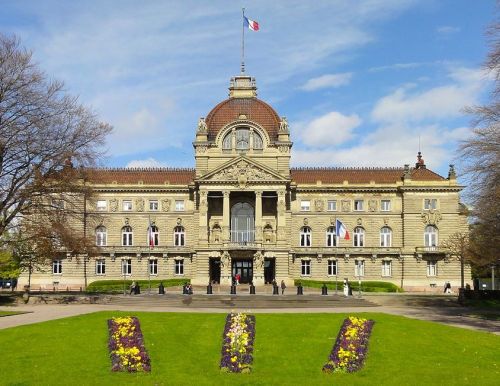Palais du Rhin, Strasbourg
Formerly known as the Kaiserpalast, the Palais du Rhin in the German quarter of Neustadt was constructed by the Germans at the end of the 19th century following their annexation of Alsace.

Formerly known as the Kaiserpalast, the Palais du Rhin in the German quarter of Neustadt was constructed by the Germans at the end of the 19th century following their annexation of Alsace. It was originally built as a palace for the Emperor of the German Reich, then used as a military hospital during World War I, and subsequently as the headquarters of the Zentralkommission für die Rheinschifffahrt or Central Commission for Rhine Shipping from 1920 onwards. In 1940, it became the headquarters of the local National Socialist government, and then the headquarters of French general Jacques-Philippe Leclerc de Hauteclocque from 1944. Today it is the seat of the Alsacian Direction Régionale des Affaires culturelles (DRAC).
Designed by Hermann Eggert in Prussian Neo-Renaissance style, the 3-storey palace is set in the midst of a lush complex with manicured gardens and a stable. The main facade has a projecting 2-level porch in the centre surmounted by a pediment with allegorical sculptures of virtue and work. Soaring behind the pediment is the imposing red dome of the Palais. The bases of the 4 pillars on the top level have capitals with bas-reliefs by Albert Bergmeier depicting children carrying out traditional regional activities of machinery, mining and weaving, viticulture, hunting and fishing, and agriculture. The corner pillars bear the coat-of-arms of Alsace and Lorraine. The pillars framing the door on the lower level have reliefs of atlantes.
The entrance leads to 2 vestibules which open up to the apartments originally intended for royalty in the south, and guests in the north. Explore the complex to see the Staircase of Honor, the festive hall at the back, ballroom, and the Emperor's and Empress' apartments in the east which comprise a courtroom, antechamber, reception room, lounge, and bedroom. The Rococo Empress' reception room is especially ornate, and a highlight of the complex. The top floor has private rooms, while the basement had the kitchen and boilers.
Hours
Sun
NA
Mon
14:00
17:00
Tue
14:00
17:00
Wed
14:00
17:00
Thu
14:00
17:00
Fri
14:00
16:00
Sat
NA
About Palais du Rhin
1-3 Place de la République, 67000 Strasbourg, France
+33 3 88 52 28 28
Palais du Rhin and Nearby Sights on Map

La Neustadt
Neustadt, which literally translates to 'New City', is a district of Strasbourg that was created by the Germans during the Reichsland period as a new city center

Place de la Republique
The Place de la République is a historical square located at the heart of the German quarter of Neustadt

Opéra National du Rhin
The neoclassical building of the Strasbourg Opera House on the Grande Île in Strasbourg is home to the Opéra National du Rhin

Museum Tomi Ungerer
Located in the Villa Greiner, the Musée Tomi Ungerer - International Center for Illustration is dedicated to the works of Strasbourg-born illustrator and author Tomi Ungerer

Horloge Astronomique Strasbourg
The Astronomical Clock of the Cathedral of Our Lady of Strasbourg is a Renaissance masterpiece with an automaton from the 19th century by Jean-Baptiste Schwilgue

Palais Rohan
Built in 1732-'42 and1742 as the residence of the prince-bishops and cardinals of the House of Rohan, the Palais Rohan de Strasbourg is a cultural landmark that now houses 3 museums - the Museum of Decorative Arts, the Museum of Fine Arts, and the Archaeological Museum

Cathédrale Notre Dame de Strasbourg
The stunning Cathédrale Notre-Dame de Strasbourg or Strasbourg Cathedral is the pinnacle of late-Gothic architecture

Museum Oeuvre Notre-Dame
The Musée de l’Oeuvre Notre-Dame is dedicated to Upper Rhenish fine arts and decorative arts from the early Middle Ages until 1681 when Strasbourg was a free imperial city of the Holy Roman Empire

Protestant Church of St Peter the Younger
Strasbourg has 3 churches dedicated to St Peter – an older Romanesque church Saint-Pierre-le-Vieux on Grand'Rue, the neo-Romanesque Saint-Pierre-le-Jeune Catholique onPlace Charles de Foucauld, and the Saint-Pierre-le-Jeune Protestant Church, which is a historical and architectural treasure
